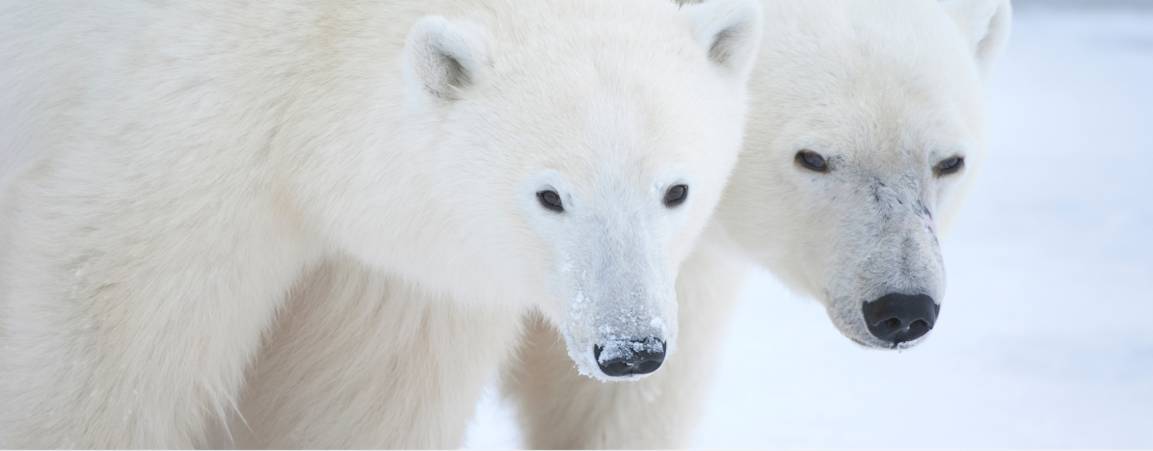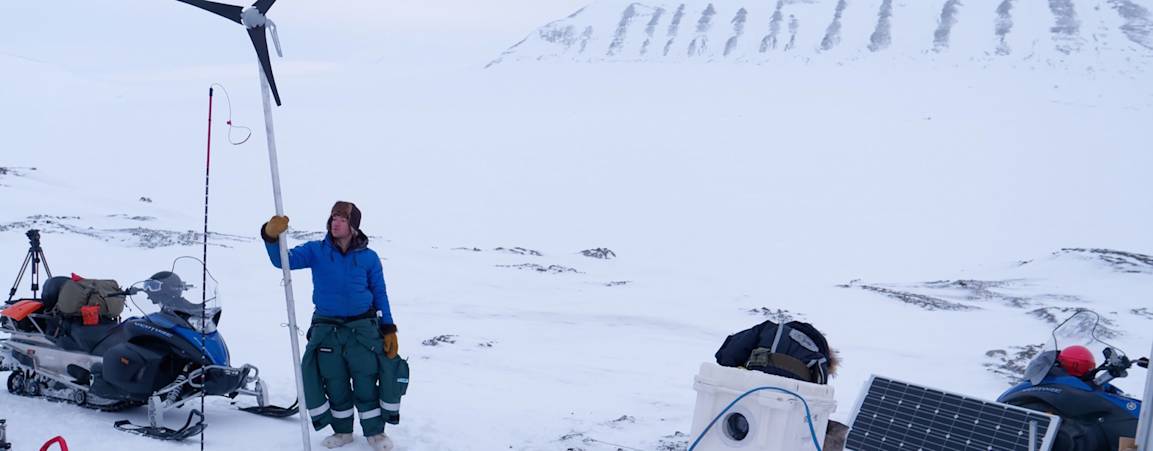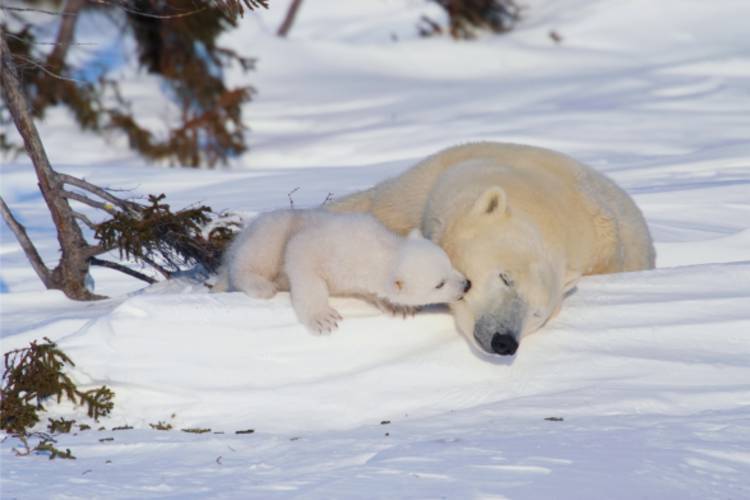Population Studies

Photo: KT Miller
Learn about population counts, traditional tracking, new methods, and what projects are happening now.
Why take population counts and track polar bears? They help scientists understand how the bears are faring. Long-term studies are especially important for understanding trends and for ringing alarm bells as necessary.
Periodic capture and handling of a small portion of polar bears provides critical health and other data - much like an annual doctor visit for you and me, or a veterinary check-up for our pets.
What we learn from population research
Size estimate and health of the population
Number of bears in each age and sex class
Movement patterns of the bears and how they're responding to changes in habitat
Hunting patterns and prey selection
Changes in distance travelled
Key denning and resting areas
Home range areas
Cub and adult survival rates
Critical data on toxics, genetics, and disease occurrence
Tracking Polar Bears

Photo: Daniel J. Cox
A small number of polar bears are tagged with tracking devices each year. This data provides information on population boundaries and habitat use that we cannot obtain any other way. Tracking data are key to answering questions around the potential impacts of an oil spill, estimating population abundance, and digging into the impacts of habitat loss or alteration. Data from the Southern Beaufort Sea population, for example, helped lead to the U.S. decision to list the polar bear as a threatened species.
How Polar Bears Are Tracked
Collars
Scientists in the field place satellite collars on a small number of bears each year in some regions of the Arctic. The technology lets research teams follow polar bears across the sea ice and land, even following mothers into dens. We have no other practical means of learning about polar bears in one of the most remote parts of our planet during polar night, when Arctic blizzards howl and temperatures plunge.
The collars are designed to fall off on their own in about 14 months. Interesting fact: only female bears can wear collars. A male polar bear's neck is wider than its head, so the collar just slips off!
You can follow some of the satellite-collared polar bears on our Polar Bear Tracker Map.
Smaller Tags
Tracking technology continues to improve, so scientists are developing new collar designs as well as alternative tracking methods. These include a small "Burr on Fur" design that we developed in partnership with 3M and tested with partners. It allows scientists to attach a small tracking device to a polar bear's fur. Scientists are also deploying eartag-based transmitters on males and sub-adults and experimenting with other types of adhesive tags.
The smaller tags don't deliver as much data or last as long as collars—but they provide scientists with a way to track adult males and subadult bears for the first time, which will add to our understanding of polar bear ecology.
Aerial Surveys
Aerial surveys let researchers take population counts from small aircraft. Polar Bears International helped fund studies to refine this approach because many parts of the Arctic are so remote that scientists can only make rough estimates about how many polar bears live there. In fact, of the 20 polar bear populations, 10 are classified as data-deficient.
Although capture efforts give us more detailed information on a population's health and movement patterns, aerial surveys will allow us to take a quick snapshot of how many bears there are in populations that we know little about.
Combining aerial surveys with genetic mark and recapture through biopsy dart sampling is an emerging tool that combines two less invasive methods to obtain critical population data in areas where traditional capture and handling are too costly or not supported by local communities.

Photo: Kt Miller / Polar Bears International


“You don’t get to the end of things with just one study. We need to commit to a particular aspect of research for 10, 20, or 30 years because you need to have that duration to get a reliable result.”
The late Dr. Ian Stirling
Former Scientific Advisor to Polar Bears International and Research Scientist Emeritus, Environment and Climate Change Canada.
Current Population Projects
Barents Sea
(Norway, Russia)
Why it matters: This population has experienced the fastest loss of sea ice habitat among the 20 recognized populations—a trend predicted to continue. As movements, distribution, prey, and denning locations shift, so will behavioral ecology and demography.
What we’re learning: This project will help researchers better understand how rapid sea ice changes impact polar bear health, reproduction, and movements, and can improve our understanding of the role genes play in population viability, a critical component in the species’ long-term conservation.
Project partners: Norwegian Polar Institute, San Diego Zoo Wildlife Alliance
Learn more: Barents Sea Polar Bears
Hudson Bay
(Canada)
Why it matters: As one of the best studied polar bear populations globally, Hudson Bay gives us a unique long term data set to examine trends and test new hypotheses that will inform areas less studied. Both the Western and Southern Hudson Bay polar bear populations have experienced declines directly tied to sea ice loss.
What we’re learning: These studies look directly at both polar bears’ on-ice ecology during their prime spring feeding period and on land ecology during the ice free period. We can gain insights into polar bear movements, reactions to changing sea ice patterns, distribution, health, predation of seals, terrestrial feeding, and defining their essential habitats. Long-term monitoring is also suggesting that the polar bears of James Bay could be a genetically unique group. These studies also refine previous research on topics like genetic aging, maladaption, and the possible merging of historical subpopulations.
How it works: These studies use a range of sampling efforts, including capture, satellite tracking, traditional and genetic mark-recapture methods, aerial surveys, biopsy darting and hair trapping, comprehensively sampling prey, and remote sensing and modelling sea ice.
Project partners: Environment and Climate Change Canada, Manitoba Natural Resources and Indigenous Futures, Ontario Ministry of Natural Resources, University of Manitoba, University of Toronto, York University, McGill University, and the University of Alberta.
Learn more: Southern Hudson Bay Polar Bears | Western Hudson Bay Polar Bears
Wrangel Island
(Russia)
This collaborative study is now on pause due to the war in Ukraine.
Why it matters: Wrangel Island, a critical resting and denning location for the data-deficient Chukchi Sea polar bears.
What we’re learning: Researchers were examining gene flow, diversity, and population dynamics to improve our understanding of how these bears fit into global polar bear diversity. Researchers were also working to improve our understanding of how Wrangel Island’s bears were handling the effects of longer ice-free seasons due to climate warming.
How it works: Researchers used ground-based observations and non-invasive genetic samples (hair traps).
Project partners: University of Washington, the Wrangel Island Nature Reserve, All-Russian Research Institute for Environment Protection and the U.S. Fish and Wildlife Service
Learn more: Chukchi Sea Polar Bears












